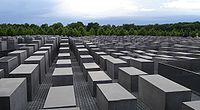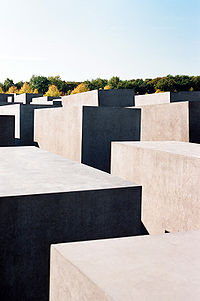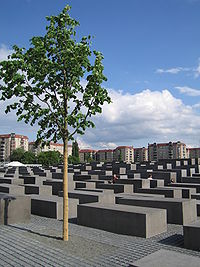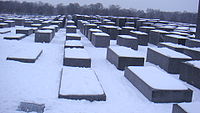- Memorial to the Murdered Jews of Europe
-
The Memorial to the Murdered Jews of Europe (German: Denkmal für die ermordeten Juden Europas), also known as the Holocaust Memorial (German: Holocaust-Mahnmal), is a memorial in Berlin to the Jewish victims of the Holocaust, designed by architect Peter Eisenman and engineer Buro Happold. It consists of a 19,000 square metres (4.7 acres) site covered with 2,711 concrete slabs or "stelae", arranged in a grid pattern on a sloping field. The stelae are 2.38 m (7 ft 10 in) long, 0.95 m (3 ft 1 in) wide and vary in height from 0.2 to 4.8 m (8 in to 15 ft 9 in). According to Eisenman's project text, the stelae are designed to produce an uneasy, confusing atmosphere, and the whole sculpture aims to represent a supposedly ordered system that has lost touch with human reason. A 2005 copy of the Foundation for the Memorial's official English tourist pamphlet, however, states that the design represents a radical approach to the traditional concept of a memorial, partly because Eisenman did not use any symbolism. An attached underground "Place of Information" (German: Ort der Information) holds the names of all known Jewish Holocaust victims, obtained from the Israeli museum Yad Vashem.
Building began on April 1, 2003 and was finished on December 15, 2004. It was inaugurated on May 10, 2005, sixty years after the end of World War II, and opened to the public on May 12 of the same year. It is located one block south of the Brandenburg Gate, in the Friedrichstadt neighborhood. The cost of construction was approximately €25 million.
The memorial is controversial, and was described by Ignatz Bubis, the then leader of the German Jewish community, as unnecessary.[citation needed]
Contents
History
German journalist Lea Rosh was the driving force behind the memorial. In 1989, she founded a group to support its construction and to collect donations. With growing support, the Bundestag passed a resolution in favour of the project.
First competition
In April 1996 a competition for its design was announced in Germany's major newspapers. Twelve artists were specifically invited to submit a design and given 50,000 DM (€ 25,000) to do so. The only rules and guidelines given were that building the project could only cost up to 15 million DM (€ 7.5 million). The winning proposal was to be selected by a jury consisting of representatives from the fields of art, architecture, urban design, history, politics and administration. It included a few minor celebrities such as Frank Schirrmacher, co-editor of the Frankfurter Allgemeine Zeitung. The deadline for the proposals was October 28. On May 11, an information colloquium took place in Berlin, where people interested in submitting a design could receive some more information about the nature of the memorial to be designed. Ignatz Bubis, the president of the Zentralrat der Juden in Deutschland, and Wolfgang Nagel, the construction senator of Berlin, spoke at the event.[1]
Before the deadline, the documents required to submit a proposal were requested over 2600 times and 528 proposals were submitted. The jury met on January 15, 1995 to pick the best submission. First, Walter Jens, the president of the Akademie der Künste was elected chairman of the jury. In the following days, all but 13 submissions were eliminated from the race in several rounds of looking through all works. As had already been arranged, the jury met again on March 15. 11 submissions were restored to the race as requested by several jurors, after they had had a chance to review the eliminated works in the months in between the meetings. Two works were then recommended by the jury to the foundation to be checked as to whether they could be completed within the price range given. One was designed by a group around the architect Simon Ungers from Hamburg; it consisted of 85x85 m square of steel girders on top of concrete blocks located on the corners. The names of several extermination camps would be perforated into the girders, so that these would be projected onto objects or people in the area by sunlight. The other winner was a design by Christine Jackob-Marks. Her concept consisted of 100x100 m large concrete plate, 7 meters thick. It would be tilted, rising up to 11 meters and walkable on special paths. The names of the Jewish victims of the Holocaust would be engraved into the concrete, with spaces left empty for those victims whose names remain unknown. Large pieces of debris from Massada, a mountaintop-fortress in Israel, whose Jewish inhabitants killed themselves to avoid being captured or killed by the Roman soldiers rushing in, would be spread over the concrete plate. These plans would eventually be vetoed by Chancellor Helmut Kohl.
Peter Eisenman's plan emerged as the winner of the next competition in November 1997. On June 25, 1999, a large majority of the Bundestag decided in favor of Eisenman's plan, modified by attaching a museum, or "place of information," designed by Berlin-based exhibition designer Dagmar von Wilcken. Across the street from the northern boundary of the memorial is the new Embassy of the United States in Berlin, which opened July 4, 2008. For a while, issues over setback for U.S. embassy construction impacted the memorial. Construction of the memorial started in April 2003.
Degussa incident
On October 14, 2003, the Swiss newspaper Tages-Anzeiger published a few articles presenting as a scandal the fact that the Degussa company was involved in the construction of the memorial producing the anti-graffiti substance Protectosil used to cover the stelae, because the company had been involved in various ways in the National-Socialist persecution of the Jews. A subsidiary company of Degussa, Degesch, had even produced the Zyklon B gas used to poison people in the gas chambers. At first these articles did not receive much attention, until the board of trustees managing the construction discussed this situation on October 23 and, after turbulent and controversial discussions, decided to stop construction immediately until a decision was made. Primarily it was representatives of the Jewish community who had called for an end to Degussa's involvement, while the politicians on the board, including Wolfgang Thierse, did not want to stop construction and incur further expense. They also said it would be impossible to exclude all German companies involved in the Nazi crimes, because — as Thierse put it — "the past intrudes into our society".[2] Lea Rosh, who also advocated excluding Degussa, replied that "Zyklon B is obviously the limit."[3] In the discussions that followed, several facts emerged. For one, it transpired that it was not by coincidence that the involvement of Degussa had been publicized in Switzerland, because another company that had bid to produce the anti-graffiti substance was located there. Further, the foundation managing the construction, as well as Lea Rosh, had known about Degussa's involvement for at least a year but had not done anything to stop it. Rosh then claimed she had not known about the connections between Degussa and Degesch. It also transpired that another Degussa subsidiary, Woerman Bauchemie GmbH, had already poured the foundation for the stelae. The Tages-Anzeiger also reported that Degussa had offered the anti-graffiti substance at a special low price in order to sponsor the memorial. A problem with excluding Degussa from the project was that many of the stelae had already been covered with Degussa's product. These would have to be destroyed if another company were to be used instead. The resulting cost would be about €2.34 million. In the course of the discussions about what to do, which lasted until November 13, most of the Jewish organizations including the Zentralrat der Juden in Deutschland spoke out against working with Degussa, while the architect Peter Eisenman, for one, supported it.[4] On November 13, the decision was made to continue working with the company, and was subsequently heavily criticized. Henryk M. Broder said that "the Jews don't need this memorial, and they are not prepared to declare a pig sty kosher."[5][6]
On December 15, 2004 the memorial was finished. It was dedicated on May 10, 2005 as part of the celebration of the 60th anniversary of V-E Day and opened to the public two days later.
It is estimated that some 3.5 million visitors entered the memorial in the first year it was open, or about 10,000 every day. About 490,000 people also visited the underground Information Center, 40% of them non-Germans. The foundation operating the memorial considered this a success; its head, Uwe Neumärker, called the memorial a "tourist magnet". There was also vandalism, however: swastikas were drawn on the stelae on five different occasions in this first year.[7]
Gallery
Criticisms
The memorial was the subject of years of controversy in Germany.
The monument has been criticised for only commemorating the Jewish victims of the Holocaust.[8] A monument to the persons persecuted for their sexual orientation is located across the street in the Tiergarten park.
In 1998, German novelist Martin Walser cited the Holocaust Memorial in his speech, when accepting the Peace Prize of the German Book Trade.[9] In the speech Walser decried the "exploitation of our disgrace for present purposes." He criticized the "monumentalization", and "ceaseless presentation of our shame." And: "Auschwitz is not suitable for becoming a routine-of-threat, an always available intimidation or a moral club [Moralkeule] or also just an obligation. What is produced by ritualisation, has the quality of a lip service"
See also
- Memorial to Polish Soldiers and German Anti-Fascists
- Soviet War Memorial (Treptower Park)
- Shoes on the Danube Promenade Memorial in Budapest 2005
- Holocaust memorial landscapes in Germany
Notes
- ^ Leggewie/Meyer 2005 pg. 91-94
- ^ Original quote: "Die Vergangenheit ragt in unsere Gesellschaft hinein". Quoted in Leggewie/Meyer 2005 p. 294.
- ^ Original quote: "Die Grenze ist ganz klar Zyklon B". Quoted in Leggewie/Meyer 2005 p. 294.
- ^ (German) Eisenman, Peter. "Geisel der Geschichte" in Die Zeit. October 30, 2003. Retrieved July 18, 2011.
- ^ Original quote: "Die Juden brauchen dieses Mahnmal nicht, und sind nicht bereit, eine Schweinerei als koscher zu erklären." Quoted in Leggewie/Meyer 2005 p. 296.
- ^ Leggewie/Meyer 2005 p. 287-300
- ^ (German) Wefing, Heinrich. "Sehr populär und knapp bei Kasse" in FAZ. May 9, 2006. Retrieved May 17, 2006.
- ^ http://news.bbc.co.uk/1/hi/world/europe/4533463.stm, under heading 'Hierarchy of victims?'.
- ^ http://www.dhm.de/lemo/html/dokumente/WegeInDieGegenwart_redeWalserZumFriedenspreis/ Full text in German
References
- Christian Saehrendt: „The Holocaust Memorial in Berlin“. In: The Burlington Magazine, Dezember 2005.
- (German) Leggewie, Claus/Meyer, Erik: "»Ein Ort, an den man gerne geht«". Carl Hanser Verlag. 2005. ISBN 3-446-20586-1
- http://www.goethe.de/kue/arc/dos/dos/zdk/en204106.htm
External links
- The Economist: Germany's Jews (Jan. 3, 2008)
- Memorial to the Murdered Jews of Europe at Archiplanet
- Home page of the project
- 360° Panorama inside the memorial
- The Memorial is at 52°30′50″N 13°22′42″E / 52.513923°N 13.378344°ECoordinates: 52°30′50″N 13°22′42″E / 52.513923°N 13.378344°E
- Review in EXBERLINER Magazine
- Photographs of the Memorial
Categories:- Holocaust memorials
- Jewish German history
- Monuments and memorials in Germany
- Buildings and structures in Mitte
- Jews and Judaism in Berlin
Wikimedia Foundation. 2010.












